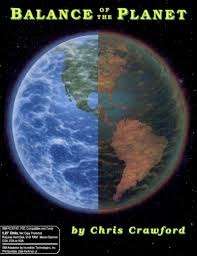Balance of the Planet
Balance of the Planet is a 1990 environmental-based educational simulator developed by Chris Crawford and published on DOS, Macintosh, and PC-98.
| Balance of the Planet | |
|---|---|
 | |
| Developer(s) | Chris Crawford |
| Publisher(s) | Chris Crawford |
| Platform(s) | Macintosh operating systems |
| Release | 1990 |
| Genre(s) | Educational, simulation |
Development
Chris Crawford was approached in early 1989 by Epyx's Joe Miller about working on an environmental game to coincide with the film Voice of the Planet to be released for Earth Day 1990. While wary of licensed games, he developed a design concept that explored the intricate connections between ecological and economic factors. He created a hypertext system to house his game. In order to place values into the game (e.g. whether the economic value of a factory is worth the deaths from air pollution), Crawford was forced to place a value on human life; he spent a lot of time treading on eggshells before conceding that no matter what value-based decisions he made he would be accused of bias.[1] Crawford designed the title as a serious game; to be very educational but not necessarily a lot of fun.[2]
Crawford self-published the game in April 1990. Shortly after the release, the game received a scathing review by the senior editor of a popular magazine. Crawford thought the review was unfair and based on a cursory play of the game, so he sent a letter in which he refutes each point made. The reviewer offered to publish his comments as a letter to the editor. The letter was never published. Four months later, the editor wrote a letter to the Computer Game Developers' Conference requesting special arrangements for an event he was setting up. Despite Crawford's position as chairman of the board, he was amenable to the editor despite their checkered history due to having his CGDC hat on so doing what was best for the conference.[1]
In 2012, Crawford created a Kickstarter project for a remake of Balance of the Planet, which would be made free on the internet. He didn't take into account that donors would be wary to pay for a project that might never be released or fall way behind schedule. For this reason, he asserted that Balance of the Planet's Kickstarter became a dismal failure.[3] 264 backers pledged a total of $13,594 out of a $150,000 fund goal.[4]
Gameplay
The gameplay sees the player balance global economic and ecological forces through taxation and expenditure, with each policy change having a runoff effect to other areas. For instance, clearing forests changes the level of CO2 in the air, which affects global warming.[5] The game has a procedural system with limited user interaction.[5]
Chris Crawford notes that it is difficult to "win" level one due to the state is already in.[6]
Reception
Persuasive Games: The Expressive Power of Videogames felt the game was sophisticated, complex, and expressive.[5] The Games Machine thought the game would be perfect to play ins schools and colleges due to being educational, easy to use, and quick to play.[7] Compute Magazine wrote that the game offered a challenging, intellectual, effective, and thoughtful consideration of the "ultimate puzzle" that world leaders face on a day-to-day basis.[8] Environmental History Review appreciate that the title challenged the common desire for people to find simple solutions to complex problems.[9]
Macworld reviewed the Macintosh version of Balance of the Planet, noting the grim and serious nature of the game, stating that "the results are rather grim ... you'll get some improvements in the state of the ecology, but you'll most likely get the soul-shivering message that millions have starved to death during your administration." They noted that Balance of the Planet contains some interesting information in regards to ecology, but criticized its "uninteresting interface" and "too little information on how the simulation works", remarking that "the most obvious way to find out the gross effects of any of the more than 20 variables is to slog it out with the emperical method: change only one variable to its maximum value, step through all nine stages of the game, note the results, start over, change the same variable to its minimum value, and repeat the process." Macworld was frustrated by this trial and error tedium to discern the meaning behind the manipulatable variables.[6]
References
- Crawford, Chris (2003). Chris Crawford on Game Design. New Riders. p. 472. ISBN 9780131460997.
Balance of the Planet crawford.
- Chalk, Andy (August 25, 2012). "Balance of Power Creator Says Kickstarter Used To Be Cool". The Escapist. Retrieved 2018-03-20.
- Curtis, Tom (August 24, 2012). "Chris Crawford reflects on a Kickstarter gone wrong". Gamasutra. Retrieved 2018-03-20.
- "Balance of the Planet". Kicktraq. August 29, 2012. Retrieved 2018-03-20.
- Bogost, Ian (2010-08-13). Persuasive Games: The Expressive Power of Videogames. MIT Press. ISBN 9780262261944.
- Moran, Tom (November 1990). "Balance of the Planet 1.0 Review". Macworld. Mac Publishing. p. 227–229.
- "Balance of the Planet". The Games Machine. 32: 78. July 1990.
- Mann, Richard O. (January 1991). "Balance of the Planet". Compute!. 125: 90.
- Holder, Dan (1991-12-01). "Balance of the Planet. By Chris Crawford. (Milpitas, CA: Chris Crawford Games, 1990.)". Environmental History Review. 15 (4): 119–120. doi:10.2307/3985008. ISSN 1053-4180. JSTOR 3985008.